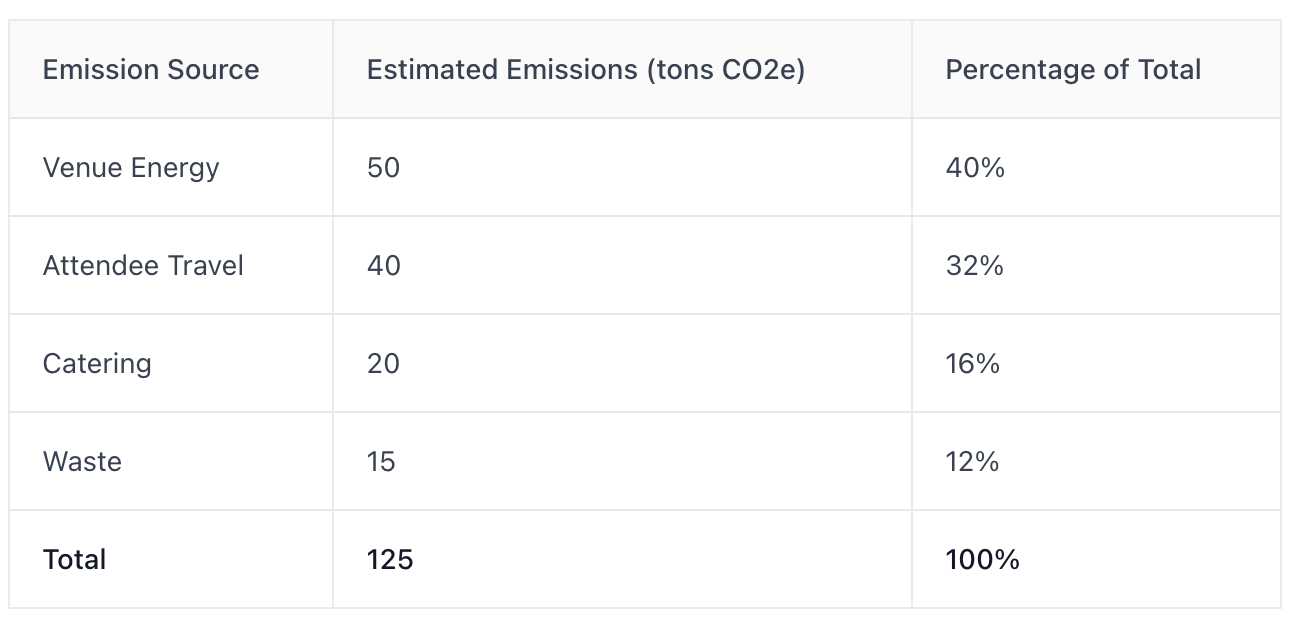Register as an organizer
Click the button below and finish your organizer registration, or fill out the form and we will be in touch to assist you.
.jpeg)
Planning an event means thinking about a lot of things, and these days, how it affects the planet is a big one. People are really starting to care about the environment, and that includes events. We're talking about everything from small gatherings to big conferences. It’s all about figuring out the carbon footprint tracking for live events, which is just a fancy way of saying we need to see how much carbon pollution an event creates. Then, we can work on making it better. This guide will walk you through how to do just that, step by step, so your next event can be more eco-friendly.
Okay, so what is a carbon footprint when we're talking about events? Basically, it's the total amount of greenhouse gases – think carbon dioxide, methane, and a few others – that are released into the atmosphere because of your event. This includes everything from the energy used to power the venue to the transportation of attendees and the waste generated. It's a way of measuring the overall impact your event has on the climate.
It's easy to overlook some of the smaller things that contribute to your event's carbon footprint, but they all add up. Thinking about these things upfront can make a big difference.
Lots of things contribute to an event's carbon footprint. Here are some of the big ones:
Why should you even bother tracking your event's carbon footprint? Well, for starters, it's about being responsible. Events can have a significant impact, and it's important to understand and minimize that impact. Tracking helps you identify where the biggest problems are so you can focus your efforts on making improvements. Plus, more and more attendees are starting to care about sustainability, so showing that you're taking action can boost your reputation. Finally, it can even save you money in the long run by identifying areas where you can reduce waste and energy consumption.

It's easy to say you want to reduce your event's impact, but you can't manage what you don't measure. Getting a handle on your event's carbon footprint is the first, and arguably most important, step. It's like figuring out where your money goes before you start budgeting – you need to know the numbers.
When it comes to measuring emissions, you can't just wing it. You need to use established, internationally recognized standards. Think of it like baking a cake – you wouldn't just throw in random ingredients and hope for the best, right? You'd follow a recipe. Similarly, standards like the ISO provide a framework for accurate carbon measurement, ensuring that your calculations are consistent and reliable. This is important for comparing your event's performance over time and against other events.
To really understand your event's impact, you need to track everything. This means looking at all aspects of the event lifecycle, from the energy used to power the venue to the waste generated by attendees. It's not enough to just look at the big things; you need to consider all the smaller details too. Here's a breakdown of what comprehensive tracking involves:
Getting a complete picture of your event's carbon footprint requires a detailed assessment of all emission sources. This includes everything from venue energy consumption and transportation to waste management and attendee activities. By understanding the full scope of your impact, you can develop targeted strategies for reduction and offsetting.
Once you've gathered all the data, the next step is to figure out where the biggest problems are. Which areas are contributing the most to your event's carbon footprint? These are your emission hotspots. Maybe it's the transportation of attendees, the energy consumption of the venue, or the waste generated during the event. Identifying these hotspots allows you to focus your efforts on the areas where you can make the biggest difference.
Here's a simple table to illustrate how to identify hotspots:

As you can see, venue energy and attendee travel are the biggest contributors, so those are the areas you'd want to focus on first. You can use this information to make informed decisions about how to reduce your event's impact. For example, you might consider switching to a renewable energy source for the venue or encouraging attendees to use public transportation. Understanding your event's carbon footprint is the first step towards creating a more sustainable event.
Okay, so you've figured out where your event's carbon is coming from. Now what? Time to actually do something about it! This is where you create a plan to cut those emissions down. It's not always easy, but it's super important.
There are a bunch of ways to tackle this. One of the biggest things you can do is look at your energy use. Are you using a venue powered by renewable energy? If not, can you find one that is? What about the food? Sourcing local and seasonal ingredients can make a big difference. Here's a quick list of ideas:
Think about going hybrid. Seriously. If you can get some of your attendees to participate virtually, you're cutting down on travel emissions big time. Plus, it can actually increase your reach. More people can attend if they don't have to travel! It's a win-win.
Hybrid events can significantly reduce your carbon footprint by decreasing travel-related emissions. They also offer increased accessibility and broader audience engagement, making them a sustainable and inclusive choice.
It's all about making smart choices. Ditch the single-use plastics. Go digital with your event materials. Encourage attendees to bring their own water bottles. Even small changes can add up. Here's a table showing potential impact:

Okay, so you've done everything you can to reduce your event's carbon footprint. You've cut down on waste, chosen a sustainable venue, and encouraged attendees to use public transport. But let's face it, some emissions are just unavoidable. That's where carbon offsetting comes in. It's not a get-out-of-jail-free card, but it's a way to balance the scales.
Carbon offsets allow you to compensate for your event's remaining emissions by investing in projects that reduce greenhouse gases elsewhere. Think of it as balancing a checkbook – you're essentially 'canceling out' your event's impact. It's important to remember that offsetting should be a last resort, after you've exhausted all other reduction strategies. It's not about buying your way out of responsibility; it's about taking accountability for the emissions you can't eliminate.
Not all carbon credits are created equal. You need to do your homework to make sure you're investing in projects that are actually making a difference. Look for credits that are:
Choosing the right carbon credits can be tricky. It's worth doing some research and potentially working with a reputable provider to ensure your investment is making a real impact. Don't be afraid to ask questions and demand transparency.
When you purchase carbon credits, you're essentially financing projects that reduce greenhouse gases. These projects can take many forms, such as:
By investing in these projects, you're not only offsetting your event's emissions but also supporting sustainable development and environmental conservation. It's a win-win situation. You can even choose local projects to show your support for environmental initiatives in Canada. This helps you achieve your carbon neutrality objectives by supporting certified ecological projects.
So, what exactly is a carbon neutral event? It's an event where you've balanced the carbon emissions with carbon removal. Basically, you're not adding any net carbon dioxide into the atmosphere. This doesn't mean you have zero emissions, but rather that you've offset any emissions produced. Think of it like balancing a checkbook – emissions are like expenses, and offsets are like deposits. You want to end up with a zero balance. It's a big deal for showing you care about the environment and want to reduce CO₂ emissions.
Okay, so you want to make your event carbon neutral? Here's a simplified breakdown:
Becoming carbon neutral isn't just about buying offsets. It's about making a genuine effort to reduce your impact in the first place. Offsets should be a last resort, not the first thing you think about.
Why bother going through all this trouble? Well, there are several good reasons:
It's not just about feeling good; it's about doing good. Plus, it can give you a competitive edge. People are increasingly aware of environmental issues, and they're more likely to support businesses and events that are taking action. Hosting carbon neutral events is a great way to show you're serious about sustainability.

It's easy to forget that events aren't just about the organizers; they're about the people who attend! Getting attendees involved in sustainability efforts is a big deal. It not only helps reduce the event's environmental impact but also spreads awareness and encourages sustainable behavior beyond the event itself. Think of it as creating a ripple effect.
First things first, people need to know why this matters. Provide clear and simple information about the event's carbon footprint and the impact of individual actions. Don't assume everyone understands the basics. Use signage, presentations, or even a dedicated app to share facts and figures. For example:
It's important to be transparent about the event's environmental impact. Share data on energy consumption, waste generation, and carbon emissions. This helps attendees understand the scale of the problem and motivates them to take action.
Education is great, but action is better. Give attendees practical ways to reduce their impact during the event. This could involve:
Think bigger than just the event. How can you inspire attendees to become advocates for sustainability in their own lives? Consider:
By turning attendees into climate ambassadors, you're not just reducing the event's impact; you're contributing to a larger movement for environmental responsibility.
Figuring out your event's carbon footprint can feel overwhelming, but thankfully, there are tools to help. These tools simplify the process of gathering data and calculating emissions from various event aspects. Think of them as your sustainability sidekick, making it easier to understand where your event is having the biggest impact. Many platforms exist, some are free and some are paid, but they all help you get a handle on your event's environmental impact. For example, you can use carbon accounting software to get a better handle on your emissions.
It's not just about the overall event; understanding how different teams contribute to the carbon footprint is key. By tracking emissions at the team level, you can pinpoint areas where targeted changes can make a real difference. This approach fosters accountability and encourages teams to come up with innovative solutions. For example, the catering team might explore local sourcing, while the transportation team could focus on optimizing routes or using electric vehicles. Here's a simple breakdown:
Sustainability reporting doesn't have to be a headache. Technology can automate much of the data collection and analysis, making it easier to track progress and share your achievements. Clear and concise reporting is essential for communicating your sustainability efforts to stakeholders. This includes attendees, sponsors, and the wider community. By using dedicated platforms, you can generate reports that highlight your carbon reduction strategies and their impact.
By using technology, you can transform your event's carbon footprint tracking from a daunting task into a manageable and insightful process. This not only helps you reduce your environmental impact but also enhances your event's reputation and appeal to environmentally conscious attendees.
So, there you have it. Making your event more eco-friendly isn't just some fancy idea; it's actually pretty important these days. By figuring out your event's carbon footprint and then doing something about it, you're not just helping the planet, you're also showing everyone that you care. It's a win-win, really. Every little bit helps, and when we all pitch in, we can make a real difference. Let's keep working towards events that are good for people and good for the Earth, too.
A carbon-neutral event is one where all the pollution that causes global warming is measured and then balanced out. This means that for every bit of carbon dioxide released, an equal amount is removed or prevented somewhere else. So, it's like the event has no net impact on the air.
We figure out how much pollution your event creates using a special, worldwide accepted method. We look at things like how much energy is used, how people travel to and from the event, and how much trash is made. This helps us get a full picture of your event's carbon footprint.
A carbon offset is like a special certificate. It means that one ton of carbon dioxide pollution has been stopped or taken out of the air. These certificates are checked by experts to make sure they're real. When you buy them, you're helping to pay for projects that reduce greenhouse gases, which also helps balance out the pollution your event creates.
We suggest you first figure out how much pollution your event makes before you buy carbon offsets. Knowing your event's carbon footprint helps you see exactly how much pollution is being released. Then, you'll know how many carbon offsets you need to buy to match that amount.
To balance out the pollution from your event, you can buy carbon offsets that are equal to the amount of pollution your event created. We can help you figure out your event's pollution and then pick good quality offsets. These offsets support projects that are good for the environment and often help local communities too.
Making your event carbon-neutral shows everyone that you care about the planet and want to do your part to fight climate change. It can also make your event more appealing to people who are also worried about the environment.
More blogs
Click the button below and finish your organizer registration, or fill out the form and we will be in touch to assist you.